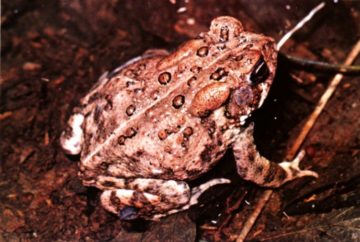When catastrophic wildfires burned through Bastrop County in 2011, victims included the region’s iconic loblolly pine trees, as well as the pine ecosystem’s resident Houston toads—an endangered species found only in Texas.
On October 22, the public will have a unique opportunity to see local efforts to protect and bring these species back, when the Pines and Prairies Land Trust hosts a traveling edition of the national Wild & Scenic Film Festival on its 600-acre ranch and wildlife refuge in Paige, about an hour’s drive east of Austin.
Billig Ranch narrowly escaped the 2011 fires, but it lies just 10 miles from Bastrop State Park, where more than 6,000 acres burned. Preventing similar damage by future wildfires is top of mind for the land trust’s staff, as is helping wildlife recover and find refuge. Houston toads aren’t found at the organization’s properties today, but they were in the past. With a little TLC, experts think the ranch could once again harbor these creatures.
“We know the potential is there,” said Melanie Pavlas, executive director of the Pines and Prairies Land Trust. “We’re working really hard to restore habitat.”

The Houston toad (anaxyrus houstonensis) is only two to three inches long, with brown or gray skin covered in dark spots that make the animal look like a little, mobile chunk of granite. It lives both in loblolly pine forests and in post oak savannahs, lying dormant underground during the summer and fall and emerging in winter and spring to breed in shallow, ephemeral ponds.
This toad is one of many species that depend on small, periodic fires to clear the forest or savannah understory and allow native grasses to grow in their wake. But in much of the United States, even small fires have been suppressed for centuries, allowing brush to build up and fuel less frequent but more destructive wildfires that can’t be contained. The Houston toad faces other threats too. It’s lost habitat to development and agriculture; young toadlets can be killed by invasive red fire ants and, like all amphibians, the toads are extremely vulnerable to chemical pollution.
The Pines and Prairies Land Trust was founded in 2001 by a group of landowners who wanted to conserve open space and wildlife amid growing development in Central Texas. Today the land trust runs three nature preserves, including Billig Ranch. Much of this land had been converted to pasture using non-native grasses, and now the land trust is using prescribed burns and other restoration techniques to recreate a more natural ecosystem.
Prescribed burns have traditionally been used by North America’s Indigenous peoples to manage the land, although the practice was largely criminalized by the U.S. government. Tribes around the country, as well as nonprofits like the Pines and Prairies Land Trust, are bringing these burns back. Unlike wildfires, prescribed burns involve setting well-controlled fire to a small area under carefully timed weather conditions. The land trust has its next burn tentatively scheduled for early 2023.
If these burns and other restoration efforts are successful, Pavlas said her organization can then work with state and federal wildlife officials to reintroduce the Houston toad. The Houston Zoo keeps a captive breeding population of approximately 600 toads for this purpose: The zoo has released millions of eggs into the wilds of Bastrop County since 2013. (Of course, just a small percentage survive to adulthood.)
The Pines and Prairies Land Trust hopes to receive some of these baby toads in the future. Until then, this weekend’s film festival offers an opportunity to take stock of progress so far. Proceeds from ticket sales will support the land trust’s work.
While none of this year’s films are set in Texas, several are very relevant to our state’s environmental issues. The Fish and the Flame follows a biologist and a ranch manager in Colorado on a mission to save the San Juan cutthroat trout from wildfire and extinction in a mirror image of Texas conservationists’ work to save the Houston toad. Cormie: The Pickpocket Cormorant explores the relationship between wildlife rescuers and a mischievous cormorant—a water bird often maligned as a pest, including in Texas. And Protecting the Monarch Butterfly chronicles the species’ generations-long migration from Canada to Mexico, as well as human efforts to provide safe “rest stops” along the way.
The Pines and Prairies Land Trust plants milkweed to help monarch butterflies during their migration, which happens to be at its peak in Central Texas right now. In fact, the ranch and two other preserves are home to a whole host of threatened species, including the cellophane bee, many native grassland birds, and rare bog plants.
Ultimately, helping any one of these species benefits the whole ecosystem, Pavlas explained: “When you’re managing [land] for an endangered species, restoring habitat for them restores it for all other native wildlife.”
The Wild & Scenic Film Festival will take place Saturday, October 22 outside at the Billig Ranch in Paige, Texas. Admission costs $100 per vehicle, and attendees have the option of camping at the wildlife refuge overnight for another $25. Tickets are available at: https://pplt.org/wildandscenic







